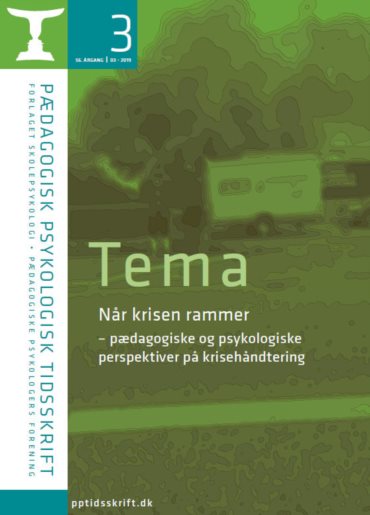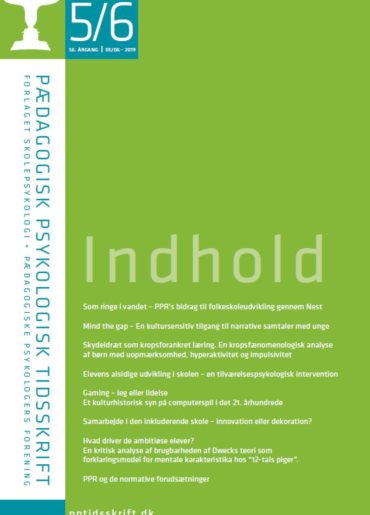Beskrivelse
Abstracts ppt 3/2019
Bernhard Meißner & Olanda Momcilovic
Crisis Management in Schools (CMiS). A Model for Supportive Intervention in Schools Following Crises / Disastrous Events
Crisis Management in Schools is a new field of school psychological work. Various influences worked together in order to make this development possible, and this article will explain why CMiS is a valuable and equal part of the development of school psychology and school education. School psychologists have the best basic qualification for being helpers in critical situations because they are counsellors in their everyday work for students, teachers, principals, other educational stakeholders and parents. When CMiS is introduced in schools, it inspires the school system to care for safety and mental health more effectively by disseminating efficient strategies and tools. The principles and strategies for interventions in schools developed by ESPCT are based on evidence and research. On this basis, the ESPCT courses are developed and regularly improved by representatives of trained groups of school psychologists throughout Europe. They are run on principles and strategieswhich have proved to be effective for training.
Maria Schnack Wolff, Kristina Bøge Meyhoff, Mette Bastrup Jensen & Npaporn Dangthongcharoen
The crisis-intervention team
Fortunately, crisis is not a part of everyday work-life at Silkeborg PPR, but even so, the crisis-intervention team is always ready to offer support and intervention when a crisis does occur. The psychologists in PPR’s crisis-intervention team have made it a priority to maintain their abilities and knowledge in crisis-intervention through regularly working on both the preparation of procedures/materials and the maintenance of competences through training. Working at PPR requires the psychologists to always position themselves according to the nature of the specific task and situation at hand, which can involve quite varied roles. The quality of crisis-intervention will be especially dependent upon the
ability to position oneself in a directive and central role – a role that is somewhat different from most of the everyday work-life at PPR. This implies a certain requirement for the crisis-intervention team to act calmly, confidently and competently in order to help “calm the waters” and bring a sense of clarity and order into a quite often chaotic situation. The case described in this article will offer an insight into the operations of the crisis-intervention team at Silkeborg PPR. The case is fictional but depicts quite accurately how the team operates during crisis-intervention.
Peter Elsass & Talli Ungar Felding (eds.)
The Trauma Support Group of The Jewish Community in Denmark
The Trauma Support Group of The Jewish Community in Denmark, consisting of volunteer Jewish and non-Jewish psychologists and other professionals with experience in psychological crisis work and traumatisation, started working immediately after the February 2015 terrorist attack in Copenhagen. The group worked with, among others, the Jewish school (Caroline School) staff, parents and children. Later we assisted the school in responding to the Kundby girl case in 2016 and at a terror exercise at the school where especially the youngest children had difficulty distinguishing between roleplay and reality. In this publication, we describe our work and what we learned from it. Since Danish schools have so far not had the need to create psychological crisis preparedness, we share our experiences with children’s, parents’ and teachers’ reactions to potentially traumatising events that can affect a school. We aim to contribute to the consideration by other schools about the necessity to create a psychological crisis preparedness plan, just as they have contingency plans regarding, for example, fires at school.
Nils Petter Reinholdt
It has been 7 years since the fateful day of 2011
It has been 7 years since the fateful day of 2011 and the terrible terrorist acts in Norway. 77 people were killed, 8 in the bomb detonated in the government quarter in Oslo, and 69 children/adolescents shot and killed by the perpetrator at Utøya, an island close to Oslo. This article will focus on some key experiences and learning points after the incident. These are primarily derived from a group of 9 youngsters who survived the terror of Utøya. The youngsters first met 5 times from November 2011 to May 2012. Their experiences were then formulated in the report “Disaster Experts” published by the Norwegian Children’s Ombudsman in June 2012. In the autumn of 2016, an initiative was taken to reunite this group, which was respect had their experiences back in 2011 characterised their lives. Another critical issue to discuss the outcome of treatment and other follow-up measures, and not least, what experiences have they now have that are useful to society and those who are going to experience the next disaster? When we re-gathered the youngsters, it was natural to follow up on many of the topics that were highlighted in the first report simply to see the development overtime. Among the topics that will be highlighted in the article are implications for personal development, trauma reactions, family dynamics, anger and substance abuse. In addition to the experiences of young people, this article will be supplemented with information from the research following the incident, reports and the evaluation of the psychosocial follow-up after the terrorist acts.
Rikke Høgsted
It takes a whole organisation to prevent a trauma
Professionals who are regularly – either directly or indirectly – confronted with accidents, threats, trauma, assaults, deaths or other violent events, or otherwise exposed to highly emotional demands, are at risk of being afflicted with stress or mental illness. Trauma exposure will affect everyone in the organisation, not just employees and managers, but also the organisation’s culture, and in everyday life, as well as under pressure, it will impair our ability to think and act clearly and professionally. Preventing the traumatisation of professionals requires that the educational institution, organisation, leader, group and employee each understand their role and responsibility, have knowledge of the psychology of burden and are familiar with wise coping strategies. Creating a healthy and sustainable working environment is a team sport that will only succeed if everyone in the organisation contributes.
Atle Dyregrov
Old and new knowledge: perspectives on crisis psychology
Crisis psychology is a field that gained momentum in the 1980s. A parallel development occurred in Scandinavian countries, partly because of work on the crisis events of daily life, and partly as a result of major catastrophic events. Awareness about the follow-up of affected groups occurred because psychologists and others started working in the field, but also because survivors and bereaved directly advocated their needs through organisations and support groups. The article emphasises the importance of providing good information to those affected by crisis events
alongside human care and support. Recent research, especially about memory, provides opportunities to influence emotional memory formation (consolidation of memories) close in time to the crisis event or through therapeutic interventions where the reconsolidation of memories is targeted later. The road ahead for future work in crisis psychology is exemplified by some areas where crisis intervention meets challenges: follow-up of time, network support, and early application of therapy.
Lillian Zøllner
Suicide, suicide attempts and self-harm among adolescents aged 13 to 19
The suicide rates among adolescents aged 15 to 19 have fallen since 2014. In 2015, a shift occurred when the suicide rate among young women was higher than the rate among young men, which had not been the case previously. The suicide attempt rates among adolescents in the North Denmark Region and Region Zealand differ greatly. The suicide attempt rates are considerably higher in the North Denmark Region than in Region Zealand. The registered adolescents have been in contact with an emergency ward due to their suicide attempt. Among young women aged 13 to 19 in the educational institutions, 26% have self-harmed once or more times. These women do not necessarily come in contact with an emergency ward.
Robert Jonasen
From a focus on unexpected responses to a structural framework within the operational field of crises intervention
Through “first hand” experience from various crises scenes, the author of this article directs focus towards the complexity in conducting a solid crises intervention. The article reflects on unexpected responses at the scene of the crisis to the crucial structural framework that supports the intervention and empathises the need




